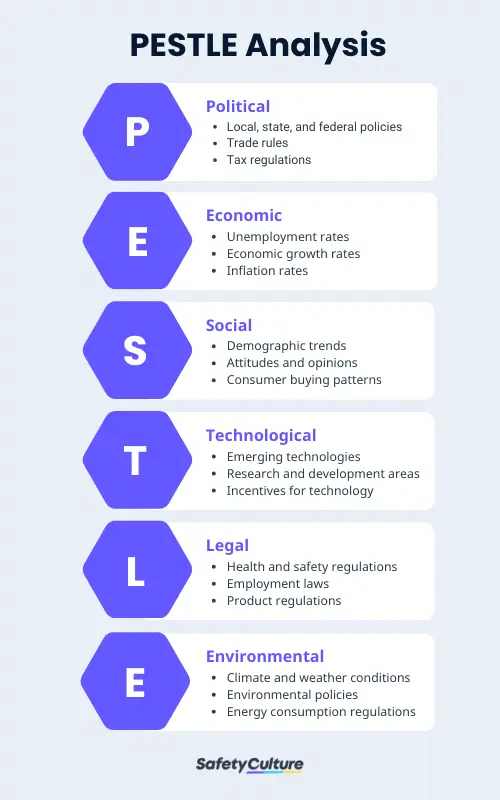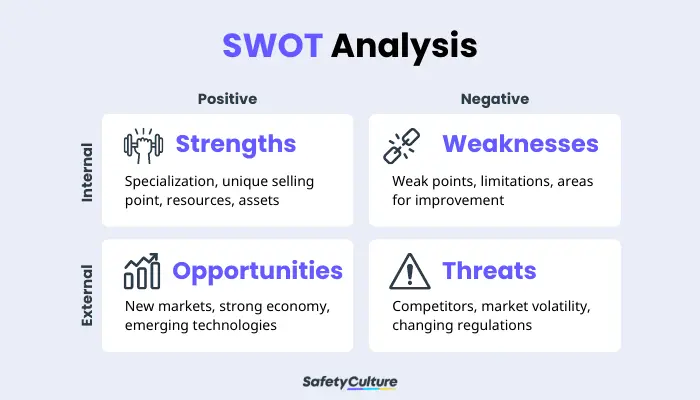What is Environmental Analysis?
An environmental analysis, also called an environmental scan, is a strategic tool used to identify and assess all external and internal elements in a business environment. It examines organizational and industry factors that can positively or negatively affect the business and its success. By anticipating short-term and long-term impacts, the organization can readily respond to them when they appear.
Purpose
An environment analysis assists organizations in defining factors that can influence their business operations. By weighing these elements, they can foresee the trajectory of their business given the circumstances. This approach allows them to develop a strategy that takes advantage of opportunities and reduces threats.
Incorporating an environmental analysis in the strategic planning sessions helps businesses systematically approach their decision-making process. This way, organizations can achieve their business goals and propel their performance to new heights.
Components
An environmental analysis consists of two major components: internal factors and external factors. This section will discuss them in detail.
Internal Factors
These components ask organizations to look inward. They examine the organization’s strong and weak points based on its mission and vision. These factors also allow businesses to reflect on their direction and plans in a set period—say, in five or ten years.
External Factors
On the other hand, external factors refer to high-level considerations that exist outside the organization. According to SHRM, businesses must examine the threats and opportunities present in the following matters:
- Industry and market trends
- Competition—their advantages and weak points
- Customers—your customer base and customer service
- Economy—economic activities that can impact the organization
- Technology—technological advancements that can streamline operations
- Labor supply—labor markets in areas of operation
- Political and legal circumstances
What are its Types?
The two common types of environmental analysis methods are the PESTLE analysis and SWOT analysis. These approaches help organizations assess their strategic positions based on a wide range of internal and external factors. Read on to learn about these methods.
PESTLE Analysis
The PESTLE analysis, or its shorter form PEST analysis, examines the factors which can influence a business on a larger scale outside the organization. It provides organizations with insights into the market status based on high-level trends concerning the market, customers, technology, and more.
The PESTLE method consists of six key elements for a comprehensive picture of the business’ macro-environment:

PESTLE Analysis
- Political – local, state, and federal government policies, trade rules, tax regulations, and so on
- Economic – unemployment rates, economic growth rates, foreign exchange rates, inflation, interest rates, and more
- Social – demographic trends, consumer buying patterns, wealth distribution, attitudes and opinions, brand recognition, and so on
- Technological – new technological discoveries and products, research and development areas, incentives for technology, and so on
- Legal – health and safety regulations, employment laws, product regulations, tariffs, and more
- Environmental – climate and weather conditions, energy consumption regulations, environmental policies, and more
SWOT Analysis
The SWOT analysis evaluates a business’ strategic standing based on internal (strengths, weaknesses) and external (opportunities, threats) factors. It uncovers a company’s advantages and disadvantages based on its strong and weak points. In doing so, companies can devise a strategy that maximizes their opportunities while mitigating potential risks.
The SWOT method takes the shape of a 2 x 2 matrix containing the following elements:

SWOT Analysis
- Strengths – What does the company do best? What is your company’s unique selling point?
- Weaknesses – What areas does your organization need to improve? What resources do you lack?
- Opportunities – What opportunities can you take advantage of based on your strengths?
- Threats – What threats do your weaknesses expose you?
Environmental Analysis Process
An environmental analysis follows a systematic process of uncovering factors that affect your business and its operations. While there’s no hard and fast rule on doing an environmental scan, these steps can guide you into making the most out of this process.
Identify the environmental factors.
An environmental analysis, first and foremost, needs a list of the factors to evaluate. These factors will depend on your organization’s industry and geographical location.
This list should include both micro and macro-environmental factors that have short-term and long-term impacts on their operations. For example, a mining company can outline the latest trends in their industry and environmental regulations in their locality.
Collect information about these factors.
After outlining the environmental factors, the next step is to gather data related to them. You can utilize various sources to make sure the information is relevant and up to date.
For example, customer satisfaction surveys inform you about how your product or service performs in the market and what improvements you can make. Meanwhile, government websites work best if you’re following updates on relevant regulations.
Check the competitors.
When doing an environmental scan, your research doesn’t stop at your organization’s business standing. It’s also necessary to scope out how your competitors are performing. A competitor analysis can help you determine any threats that can weaken your business and opportunities that set you apart from the competition.
Determine the impacts on the organization.
Once you’ve collected sufficient environmental information, you can now use them to predict how it can affect your business. This step sets your expectations, so you can prepare for the possible outcomes should these factors come your way. In assessing risks and their impacts, it’s vital to ask the following questions:
- What are the consequences of this factor on your business?
- How long will this last?
- How will this affect the business (positively, negatively, or no impact)?
- How important is this factor in the overall business operations?
Devise a strategic plan.
The final step allows you to brainstorm and formulate strategies for the possible changes from these factors. It includes assessing current strategic plans and adjusting them based on the information you have gathered about your business environment. Aside from this, you can also enumerate steps to maximize opportunities and minimize threats.
Create Your Own Business Strategic Plan
Eliminate manual tasks and streamline your operations.
Get started for FREEWhat is an Environmental Analysis Example?
This environmental analysis example illustrates how the process works. For this case, a US-based food manufacturing company, Company XYZ, wants to expand its operations globally. Company XYZ will use the PESTLE method to assess its prospective business environment and devise steps to launch its operations effectively.
This table shows the six key factors and the details of their potential impact.
| Political | Economic | Social | Technological | Legal | Environmental | |
| Potential Factors |
|
|
|
|
|
|
| Possible Outcomes |
Trade barriers in select countries |
Profitability for local versus overseas economies |
Customer reception of our food products |
Efficient manufacturing process and promotions overseas |
Entry of product to the market |
Pollution, raw material sources overseas |
| Time Frame | Unknown | 6-12 months (can extend depending on the circumstances) | 6-12 months | 0-9 months | 0-3 months | Unknown |
|
Type of Impact
|
Negative | Unknown | Unknown (possibly positive) | Positive | Unknown (possibly negative) | Unknown |
|
Importance
|
Important | Critical | Important | Moderate | Critical | Moderate |




